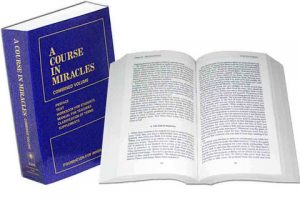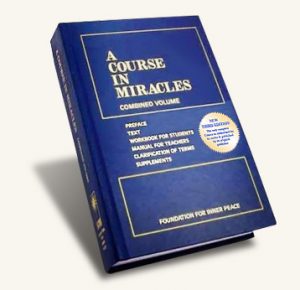As its title implies, the Course is arranged throughout as a teaching device. It consists of three books: a 622-page Text, a 478-page Workbook for Students, and an 88-page Manual for Teachers. The order in which students choose to use the books, and the ways in which they study them, depend on their particular needs and preferences.
The curriculum the Course proposes is carefully conceived and is explained, step by step, at both the theoretical and practical levels. It emphasizes application rather than theory, and experience rather than theology. It specifically states that "a universal theology is impossible, but a universal experience is not only possible but necessary." (Manual, p. 77) Although Christian in statement, the Course deals with universal spiritual themes. It emphasizes that it is but one version of the universal curriculum. There are many others, this one differing from them only in form. They all lead to God in the end.
The Text is largely theoretical, and sets forth the concepts on which the Course's thought system is based. Its ideas contain the foundation for the Workbook's lessons. Without the practical application the Workbook provides, the Text would remain largely a series of abstractions which would hardly suffice to bring about the thought reversal at which the Course aims.
The Workbook includes 365 lessons, one for each day of the year. It is not necessary, however, to do the lessons at that tempo, and one might want to remain with a particularly appealing lesson for more than one day. The instructions urge only that not more than one lesson a day should be attempted. The practical nature of the Workbook is underscored by the introduction to its lessons, which emphasizes experience through application rather than a prior commitment to a spiritual goal:
"Remember only this; you need not believe the ideas, you need not accept them, and you need not even welcome them. Some of them you may actively resist. None of this will matter, or decrease their efficacy. But do not allow yourself to make exceptions in applying the ideas the workbook contains, and whatever your reactions to the ideas may be, use them. Nothing more than that is required." (Workbook, p. 2)"Some of the ideas the workbook presents you will find hard to believe, and others may seem to be quite startling. This does not matter. You are merely asked to apply the ideas as you are directed to do. You are not asked to judge them at all. You are asked only to use them. It is their use that will give them meaning to you, and will show you that they are true."
Finally, the Manual for Teachers, which is written in question and answer form, provides answers to some of the more likely questions a student might ask. It also includes a clarification of a number of the terms the Course uses, explaining them within the theoretical framework of the Text.
 The Course makes no claim to finality, nor are the Workbook lessons intended to bring the student's learning to completion. At the end, the reader is left in the hands of his or her own Internal Teacher, Who will direct all subsequent learning as He sees fit. While the Course is comprehensive in scope, truth cannot be limited to any finite form, as is clearly recognized in the statement at the end of theWorkbook:
The Course makes no claim to finality, nor are the Workbook lessons intended to bring the student's learning to completion. At the end, the reader is left in the hands of his or her own Internal Teacher, Who will direct all subsequent learning as He sees fit. While the Course is comprehensive in scope, truth cannot be limited to any finite form, as is clearly recognized in the statement at the end of theWorkbook:
"This Course is a beginning, not an end...No more specific lessons are assigned, for there is no more need of them. Henceforth, hear but the Voice for God...He will direct your efforts, telling you exactly what to do, how to direct your mind, and when to come to Him in silence, asking for His sure direction and His certain Word." (Workbook, p. 487)


